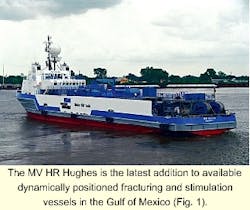Producers in the Gulf of Mexico now have available the largest proppant-capacity fracturing vessel available in the region.
Last month, Baker Oil Tools division of Baker Hughes Inc. launched the MV HR Hughes (Fig. 1). The vessel was rechristened for Howard R. Hughes who, in 1909, founded Hughes Tool Co., one of the forerunners of today's Baker Hughes oil field service company.
Edison Chouest Offshore LLC, Galliano, La., at its affiliate North American Shipbuilding yard in Larose, La., converted the C-Cadet, a more-conventional offshore vessel built in 1997.
The C-Cadet formerly performed marine seismic work in the Mediterranean Sea before returning to the South Louisiana yard for conversion. The work involved cutting the vessel in half at midsection and inserting a 50-ft extension to accommodate the extra equipment needed by Baker Oil Tools. The extension stretched the 56-ft wide boat to 270 ft and gave it 1,600 sq ft of cargo deck.
"That's the fourth conversion we've done like that in the last couple of years," said Lonnie Thibodeaux, communications director for Edison Chouest. The company retains ownership of the HR Hughes vessel, which is under a 5-year lease to Baker Oil Tools.
The vessel's seven independent, remotely operated pump skids for stimulation provide 12,500 hydraulic hp and have a maximum 60 bbl/min maximum pump rate and 50 bbl/min continuous frac-fluid pump rate. The proppant delivery system is 100% redundant and the vessel can carry 2.2 million lb of proppant, with about 1 million lb stored below decks and more than 1 million lb pumpable from equipment on deck.
"There's one vessel in the North Sea with more capacity, but I don't believe there are any in the gulf with as much capacity," said Carroll Newman, senior operations manager for Baker Oil Tools, who helped design the vessel. There are only about 26 high-performance marine fracturing and stimulation vessels in the business, depending on who's counting, he said.
The result is what Baker Oil Tools officials describe as a vessel with the most redundant offshore fracturing capability in the industry, with backups that ensure work can continue even with catastrophic failures of some onboard systems.
Other features of the stimulation equipment include independent two proppant silos with 10,200 cu ft capacity, eight main proppant bins with 10,000 lb/min transfer rate from supplies below deck, side-by-side twin blenders, backup hydraulic systems, and twin 15,000-psi Coflexip hoses that connect the pumps to the wellhead.
A low-pressure manifold from the blender to the pumps electronically reroutes gravel-packing slurry to allow treatment to continue even with the loss of a blender or frac pump. The result is two complete blending systems that can work in tandem or separately. In the event of catastrophic failure of one system, "we can immediately bring the other system up," said Newman.
The design also allows for continuous monitoring of the system, checking current performance against previous performance, to spot immediately the need for maintenance or repairs, he said.
Operating data can be transmitted in real time via satellite to Baker Hughes data rooms in Houston, New Orleans, and Lafayette, La., or even to a laptop computer almost anywhere in the world.
Moreover, Newman said, this vessel has a Class 1 dynamic positioning system with azimuthing stern thrusters and a drop-down bow thruster designed for station keeping in the widest possible operating window for weather and sea conditions in the gulf.
With the vessel's backup battery and hydraulic systems, he said, "We can maintain station for up to 2 hr in the event of a complete failure of the ship systems." Newman said, "Once we start pumping, we're committed to completing that job, so everything has got to be perfect before we start. That takes a lot of preplanning."
The MV HR Hughes was scheduled to start working in the gulf on July 1 after completing sea trials. The vessel can carry enough supplies to handle three or four jobs and stay out about 2 weeks, said Newman.
Baker Oil Tools has two other fracturing and stimulation vessels operating in the gulf: The RC Baker, launched in 1999, and the Republic Tide, which has been in service since 1998.



